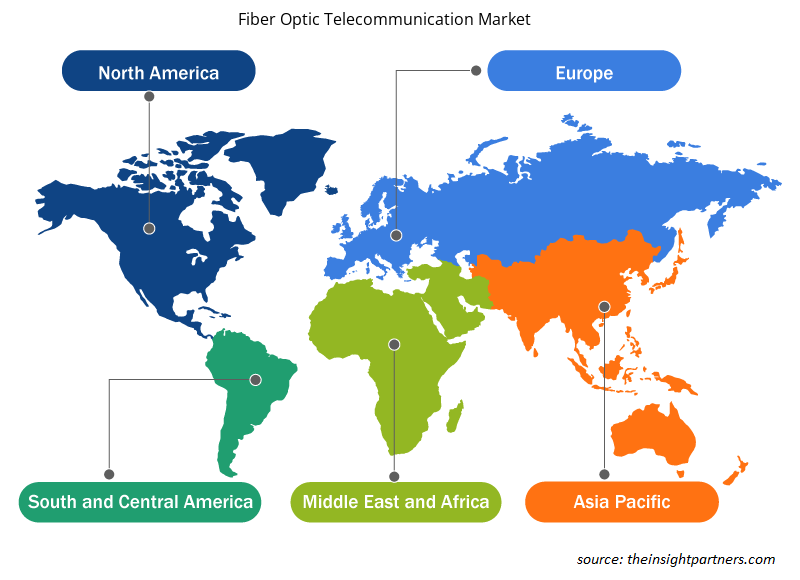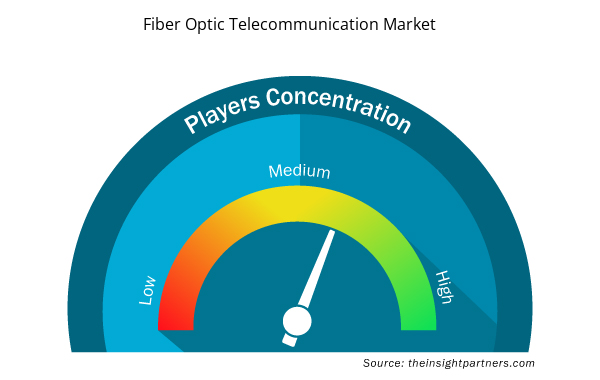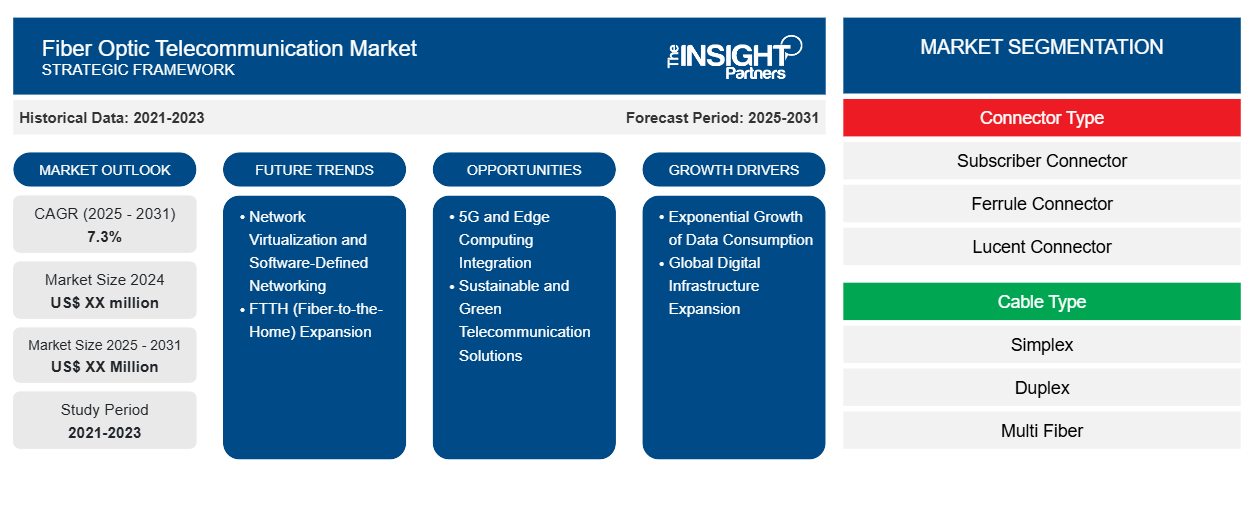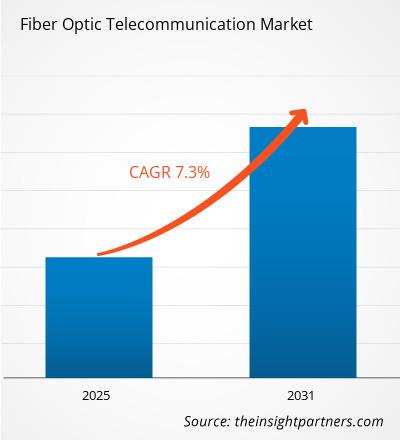Si prevede che il mercato delle telecomunicazioni in fibra ottica registrerà un CAGR del 7,3% dal 2024 al 2031, con una dimensione di mercato in espansione da XX milioni di dollari nel 2024 a XX milioni di dollari entro il 2031.
Il report è segmentato per tipo di connettore (connettore abbonato, connettore ferrula, connettore Lucent, connettore a punta dritta, altri), tipo di cavo (simplex, duplex, multifibra). L'analisi globale è ulteriormente suddivisa a livello regionale e nei principali paesi. Il report offre il valore in USD per l'analisi e i segmenti di cui sopra
Scopo del rapporto
Il report Fiber Optic Telecommunication Market di The Insight Partners mira a descrivere il panorama attuale e la crescita futura, i principali fattori trainanti, le sfide e le opportunità. Ciò fornirà spunti a vari stakeholder aziendali, come:
- Fornitori/produttori di tecnologia: per comprendere le dinamiche di mercato in evoluzione e conoscere le potenziali opportunità di crescita, consentendo loro di prendere decisioni strategiche informate.
- Investitori: condurre un'analisi completa delle tendenze in merito al tasso di crescita del mercato, alle proiezioni finanziarie del mercato e alle opportunità esistenti lungo la catena del valore.
- Enti di regolamentazione: regolamentano le politiche e le attività di controllo sul mercato allo scopo di ridurre al minimo gli abusi, preservare la fiducia degli investitori e sostenere l'integrità e la stabilità del mercato.
Segmentazione del mercato delle telecomunicazioni in fibra ottica
Tipo di connettore
- Connettore abbonato
- Connettore a ghiera
- Connettore Lucent
- Connettore a punta dritta
- Altri
Tipo di cavo
- Semplice
- Bifamiliare
- Multi fibra
Personalizza questo report in base alle tue esigenze
Riceverai la personalizzazione gratuita di qualsiasi report, comprese parti di questo report, o analisi a livello nazionale, pacchetto dati Excel, oltre a usufruire di grandi offerte e sconti per start-up e università
- Scopri le principali tendenze di mercato in questo rapporto.Questo campione GRATUITO includerà analisi di dati che spaziano dalle tendenze di mercato alle stime e alle previsioni.
Fattori trainanti della crescita del mercato delle telecomunicazioni in fibra ottica
- Crescita esponenziale del consumo di dati: la crescita esplosiva del consumo globale di dati, guidata da servizi di streaming, cloud computing, dispositivi Internet of Things (IoT) e tecnologie emergenti come 5G e intelligenza artificiale, è un motore primario del mercato delle telecomunicazioni in fibra ottica. Con l'aumento dei requisiti di larghezza di banda e la necessità di connettività ad alta velocità e bassa latenza, le reti in fibra ottica sono diventate infrastrutture essenziali. Sia i consumatori che le aziende richiedono connessioni Internet più veloci e affidabili in grado di gestire trasferimenti di dati massicci, applicazioni digitali complesse ed esperienze multimediali senza interruzioni, spingendo i fornitori di telecomunicazioni ad espandere e aggiornare le capacità delle loro reti in fibra ottica.
- Espansione globale dell'infrastruttura digitale: gli investimenti dei governi e del settore privato nell'infrastruttura digitale stanno spingendo in modo significativo il mercato delle telecomunicazioni in fibra ottica. Riconoscendo le telecomunicazioni come infrastrutture nazionali critiche, molti paesi stanno implementando iniziative strategiche per migliorare la connettività a banda larga, in particolare nelle regioni rurali e sottoservite. Questi investimenti mirano a colmare i divari digitali, supportare lo sviluppo economico, abilitare il lavoro e l'istruzione da remoto e creare reti di comunicazione robuste in grado di supportare l'innovazione tecnologica. Il riconoscimento diffuso di Internet ad alta velocità come utilità fondamentale sta guidando investimenti sostanziali nell'implementazione di reti in fibra ottica in tutto il mondo.
Tendenze future del mercato delle telecomunicazioni in fibra ottica
- Virtualizzazione di rete e reti definite dal software: l'emergere della virtualizzazione di rete e delle reti definite dal software (SDN) sta trasformando il panorama delle telecomunicazioni in fibra ottica. Queste tecnologie consentono architetture di rete più flessibili, efficienti e programmabili che possono allocare dinamicamente la larghezza di banda, ottimizzare il routing del traffico e migliorare la sicurezza della rete. Separando l'hardware di rete dai suoi meccanismi di controllo, i provider di telecomunicazioni possono creare un'infrastruttura più agile e scalabile che può adattarsi rapidamente ai requisiti tecnologici e alle richieste degli utenti in continua evoluzione, riducendo i costi operativi e migliorando le prestazioni e l'affidabilità complessive della rete.
- Espansione FTTH (Fiber-to-the-Home): la tendenza FTTH si sta espandendo rapidamente poiché i provider di servizi si concentrano sulla fornitura di Internet in fibra ottica direttamente alle abitazioni residenziali. Ciò offre velocità più elevate, maggiore affidabilità e maggiore larghezza di banda rispetto alle tradizionali connessioni in rame. Con i consumatori che richiedono Internet ad alta velocità per uffici domestici, giochi e intrattenimento, FTTH sta diventando una strategia chiave per le aziende di telecomunicazioni per soddisfare queste richieste in evoluzione e migliorare la soddisfazione del cliente.
Opportunità di mercato delle telecomunicazioni in fibra ottica
- Integrazione 5G ed Edge Computing: la convergenza delle reti in fibra ottica con la tecnologia 5G e l'edge computing rappresenta un'enorme opportunità di mercato. L'infrastruttura in fibra ottica funge da dorsale critica per supportare reti 5G ultraveloci e a bassa latenza e implementazioni di edge computing. Questa opportunità comporta lo sviluppo di soluzioni integrate in grado di supportare tecnologie emergenti come veicoli autonomi, città intelligenti, IoT industriale e telemedicina avanzata. Le aziende di telecomunicazioni possono creare valore offrendo soluzioni di connettività complete che combinano perfettamente reti in fibra ottica ad alta velocità con funzionalità wireless e edge computing avanzate.
- Soluzioni di telecomunicazione sostenibili ed ecologiche: la crescente enfasi sulla sostenibilità ambientale crea un'importante opportunità nel mercato delle telecomunicazioni in fibra ottica. I provider possono sviluppare e commercializzare soluzioni di rete ecologiche che riducono al minimo il consumo energetico, le emissioni di carbonio e supportano infrastrutture di telecomunicazione ecologiche. Ciò include l'innovazione in apparecchiature di rete a risparmio energetico, l'utilizzo di fonti di energia rinnovabili per i data center, l'implementazione di principi di economia circolare nella progettazione di reti e lo sviluppo di tecnologie che ottimizzano le prestazioni di rete riducendo al minimo l'impatto ambientale. Le aziende che integrano con successo la sostenibilità nelle loro strategie di rete in fibra ottica possono differenziarsi e attrarre consumatori e aziende attenti all'ambiente.
Approfondimenti regionali sul mercato delle telecomunicazioni in fibra ottica
Le tendenze regionali e i fattori che influenzano il mercato delle telecomunicazioni in fibra ottica durante il periodo di previsione sono stati ampiamente spiegati dagli analisti di Insight Partners. Questa sezione discute anche i segmenti e la geografia del mercato delle telecomunicazioni in fibra ottica in Nord America, Europa, Asia Pacifico, Medio Oriente e Africa e America centrale e meridionale.

- Ottieni i dati specifici regionali per il mercato delle telecomunicazioni in fibra ottica
Ambito del rapporto sul mercato delle telecomunicazioni in fibra ottica
| Attributo del report | Dettagli |
|---|---|
| Dimensioni del mercato nel 2024 | XX milioni di dollari USA |
| Dimensioni del mercato entro il 2031 | XX milioni di dollari USA |
| CAGR globale (2025 - 2031) | 7,3% |
| Dati storici | 2021-2023 |
| Periodo di previsione | 2025-2031 |
| Segmenti coperti | Per tipo di connettore
|
| Regioni e Paesi coperti | America del Nord
|
| Leader di mercato e profili aziendali chiave |
|
Densità degli operatori del mercato delle telecomunicazioni in fibra ottica: comprendere il suo impatto sulle dinamiche aziendali
Il mercato delle telecomunicazioni in fibra ottica sta crescendo rapidamente, spinto dalla crescente domanda degli utenti finali dovuta a fattori quali l'evoluzione delle preferenze dei consumatori, i progressi tecnologici e una maggiore consapevolezza dei vantaggi del prodotto. Con l'aumento della domanda, le aziende stanno ampliando le loro offerte, innovando per soddisfare le esigenze dei consumatori e capitalizzando sulle tendenze emergenti, il che alimenta ulteriormente la crescita del mercato.
La densità degli operatori di mercato si riferisce alla distribuzione di aziende o società che operano in un particolare mercato o settore. Indica quanti concorrenti (operatori di mercato) sono presenti in un dato spazio di mercato in relazione alle sue dimensioni o al valore di mercato totale.
Le principali aziende che operano nel mercato delle telecomunicazioni in fibra ottica sono:
- Società Amphenol
- Società anonima
- Società anonima
- Corning Incorporata
- Estrone
Disclaimer : le aziende elencate sopra non sono classificate secondo un ordine particolare.

- Ottieni una panoramica dei principali attori del mercato delle telecomunicazioni in fibra ottica
Punti di forza chiave
- Copertura completa: il rapporto copre in modo completo l'analisi di prodotti, servizi, tipologie e utenti finali del mercato delle telecomunicazioni in fibra ottica, fornendo una panoramica olistica.
- Analisi degli esperti: il rapporto è compilato sulla base della conoscenza approfondita di esperti e analisti del settore.
- Informazioni aggiornate: il rapporto garantisce la pertinenza aziendale grazie alla copertura di informazioni recenti e tendenze nei dati.
- Opzioni di personalizzazione: questo report può essere personalizzato per soddisfare le esigenze specifiche del cliente e adattarsi in modo appropriato alle strategie aziendali.
Il rapporto di ricerca sul mercato delle telecomunicazioni in fibra ottica può, quindi, aiutare a guidare il percorso di decodifica e comprensione dello scenario del settore e delle prospettive di crescita. Sebbene possano esserci alcune preoccupazioni valide, i vantaggi complessivi di questo rapporto tendono a superare gli svantaggi.
- Analisi storica (2 anni), anno base, previsione (7 anni) con CAGR
- Analisi PEST e SWOT
- Valore/volume delle dimensioni del mercato - Globale, regionale, nazionale
- Industria e panorama competitivo
- Set di dati Excel



Report Coverage
Revenue forecast, Company Analysis, Industry landscape, Growth factors, and Trends

Segment Covered
This text is related
to segments covered.

Regional Scope
North America, Europe, Asia Pacific, Middle East & Africa, South & Central America

Country Scope
This text is related
to country scope.
Domande frequenti
The report can be delivered in PDF/PPT format; we can also share excel dataset based on the request
Network virtualization and software-defined networking to play a significant role in the global fiber optic telecommunication market in the coming years
The Fiber Optic Telecommunication Market is estimated to witness a CAGR of 7.3% from 2023 to 2031
Exponential growth of data consumption and digital infrastructure expansion are the majors factor driving the fiber optic telecommunication market
Trends and growth analysis reports related to Technology, Media and Telecommunications : READ MORE..
1. Amphenol Corporation
2. CommScope Inc.
3. Connectix Ltd.
4. Corning Incorporated
5. Extron
6. Fischer Connectors SA
7. Huihong Technologies Limited
8. Leoni AG
9. Molex LLC
10. TE Connectivity
The Insight Partners performs research in 4 major stages: Data Collection & Secondary Research, Primary Research, Data Analysis and Data Triangulation & Final Review.
- Data Collection and Secondary Research:
As a market research and consulting firm operating from a decade, we have published and advised several client across the globe. First step for any study will start with an assessment of currently available data and insights from existing reports. Further, historical and current market information is collected from Investor Presentations, Annual Reports, SEC Filings, etc., and other information related to company’s performance and market positioning are gathered from Paid Databases (Factiva, Hoovers, and Reuters) and various other publications available in public domain.
Several associations trade associates, technical forums, institutes, societies and organization are accessed to gain technical as well as market related insights through their publications such as research papers, blogs and press releases related to the studies are referred to get cues about the market. Further, white papers, journals, magazines, and other news articles published in last 3 years are scrutinized and analyzed to understand the current market trends.
- Primary Research:
The primarily interview analysis comprise of data obtained from industry participants interview and answers to survey questions gathered by in-house primary team.
For primary research, interviews are conducted with industry experts/CEOs/Marketing Managers/VPs/Subject Matter Experts from both demand and supply side to get a 360-degree view of the market. The primary team conducts several interviews based on the complexity of the markets to understand the various market trends and dynamics which makes research more credible and precise.
A typical research interview fulfils the following functions:
- Provides first-hand information on the market size, market trends, growth trends, competitive landscape, and outlook
- Validates and strengthens in-house secondary research findings
- Develops the analysis team’s expertise and market understanding
Primary research involves email interactions and telephone interviews for each market, category, segment, and sub-segment across geographies. The participants who typically take part in such a process include, but are not limited to:
- Industry participants: VPs, business development managers, market intelligence managers and national sales managers
- Outside experts: Valuation experts, research analysts and key opinion leaders specializing in the electronics and semiconductor industry.
Below is the breakup of our primary respondents by company, designation, and region:

Once we receive the confirmation from primary research sources or primary respondents, we finalize the base year market estimation and forecast the data as per the macroeconomic and microeconomic factors assessed during data collection.
- Data Analysis:
Once data is validated through both secondary as well as primary respondents, we finalize the market estimations by hypothesis formulation and factor analysis at regional and country level.
- Macro-Economic Factor Analysis:
We analyse macroeconomic indicators such the gross domestic product (GDP), increase in the demand for goods and services across industries, technological advancement, regional economic growth, governmental policies, the influence of COVID-19, PEST analysis, and other aspects. This analysis aids in setting benchmarks for various nations/regions and approximating market splits. Additionally, the general trend of the aforementioned components aid in determining the market's development possibilities.
- Country Level Data:
Various factors that are especially aligned to the country are taken into account to determine the market size for a certain area and country, including the presence of vendors, such as headquarters and offices, the country's GDP, demand patterns, and industry growth. To comprehend the market dynamics for the nation, a number of growth variables, inhibitors, application areas, and current market trends are researched. The aforementioned elements aid in determining the country's overall market's growth potential.
- Company Profile:
The “Table of Contents” is formulated by listing and analyzing more than 25 - 30 companies operating in the market ecosystem across geographies. However, we profile only 10 companies as a standard practice in our syndicate reports. These 10 companies comprise leading, emerging, and regional players. Nonetheless, our analysis is not restricted to the 10 listed companies, we also analyze other companies present in the market to develop a holistic view and understand the prevailing trends. The “Company Profiles” section in the report covers key facts, business description, products & services, financial information, SWOT analysis, and key developments. The financial information presented is extracted from the annual reports and official documents of the publicly listed companies. Upon collecting the information for the sections of respective companies, we verify them via various primary sources and then compile the data in respective company profiles. The company level information helps us in deriving the base number as well as in forecasting the market size.
- Developing Base Number:
Aggregation of sales statistics (2020-2022) and macro-economic factor, and other secondary and primary research insights are utilized to arrive at base number and related market shares for 2022. The data gaps are identified in this step and relevant market data is analyzed, collected from paid primary interviews or databases. On finalizing the base year market size, forecasts are developed on the basis of macro-economic, industry and market growth factors and company level analysis.
- Data Triangulation and Final Review:
The market findings and base year market size calculations are validated from supply as well as demand side. Demand side validations are based on macro-economic factor analysis and benchmarks for respective regions and countries. In case of supply side validations, revenues of major companies are estimated (in case not available) based on industry benchmark, approximate number of employees, product portfolio, and primary interviews revenues are gathered. Further revenue from target product/service segment is assessed to avoid overshooting of market statistics. In case of heavy deviations between supply and demand side values, all thes steps are repeated to achieve synchronization.
We follow an iterative model, wherein we share our research findings with Subject Matter Experts (SME’s) and Key Opinion Leaders (KOLs) until consensus view of the market is not formulated – this model negates any drastic deviation in the opinions of experts. Only validated and universally acceptable research findings are quoted in our reports.
We have important check points that we use to validate our research findings – which we call – data triangulation, where we validate the information, we generate from secondary sources with primary interviews and then we re-validate with our internal data bases and Subject matter experts. This comprehensive model enables us to deliver high quality, reliable data in shortest possible time.


 Ottieni un campione gratuito per questo repot
Ottieni un campione gratuito per questo repot